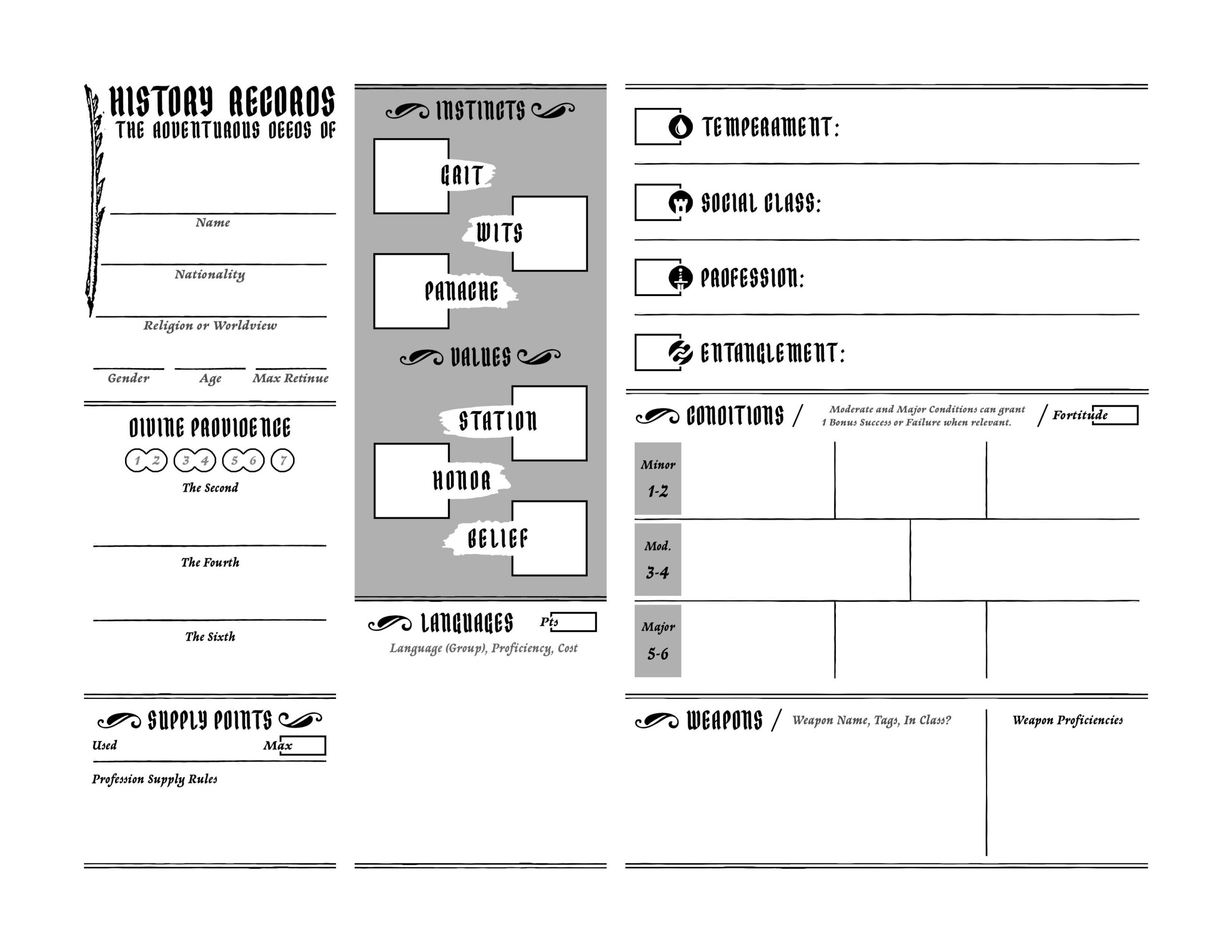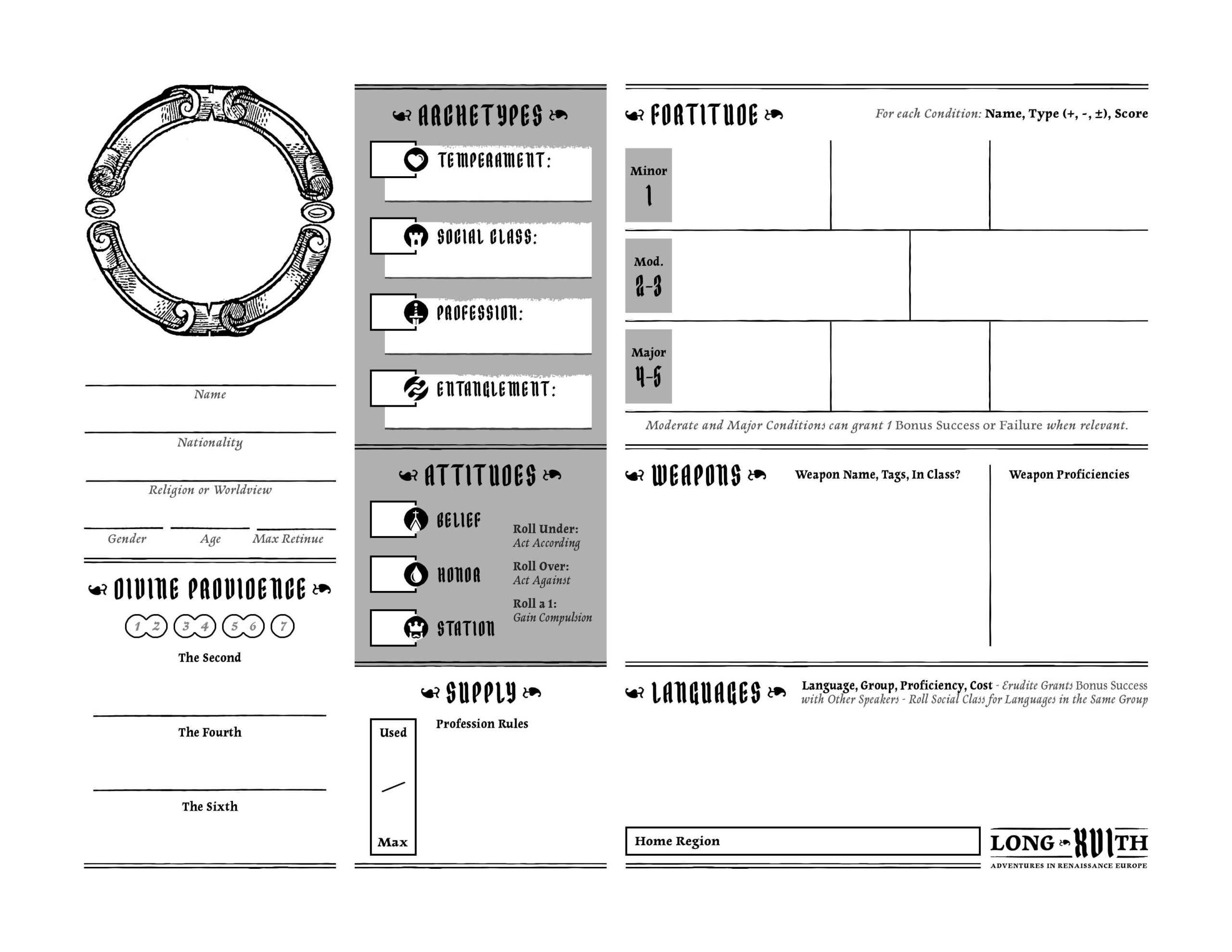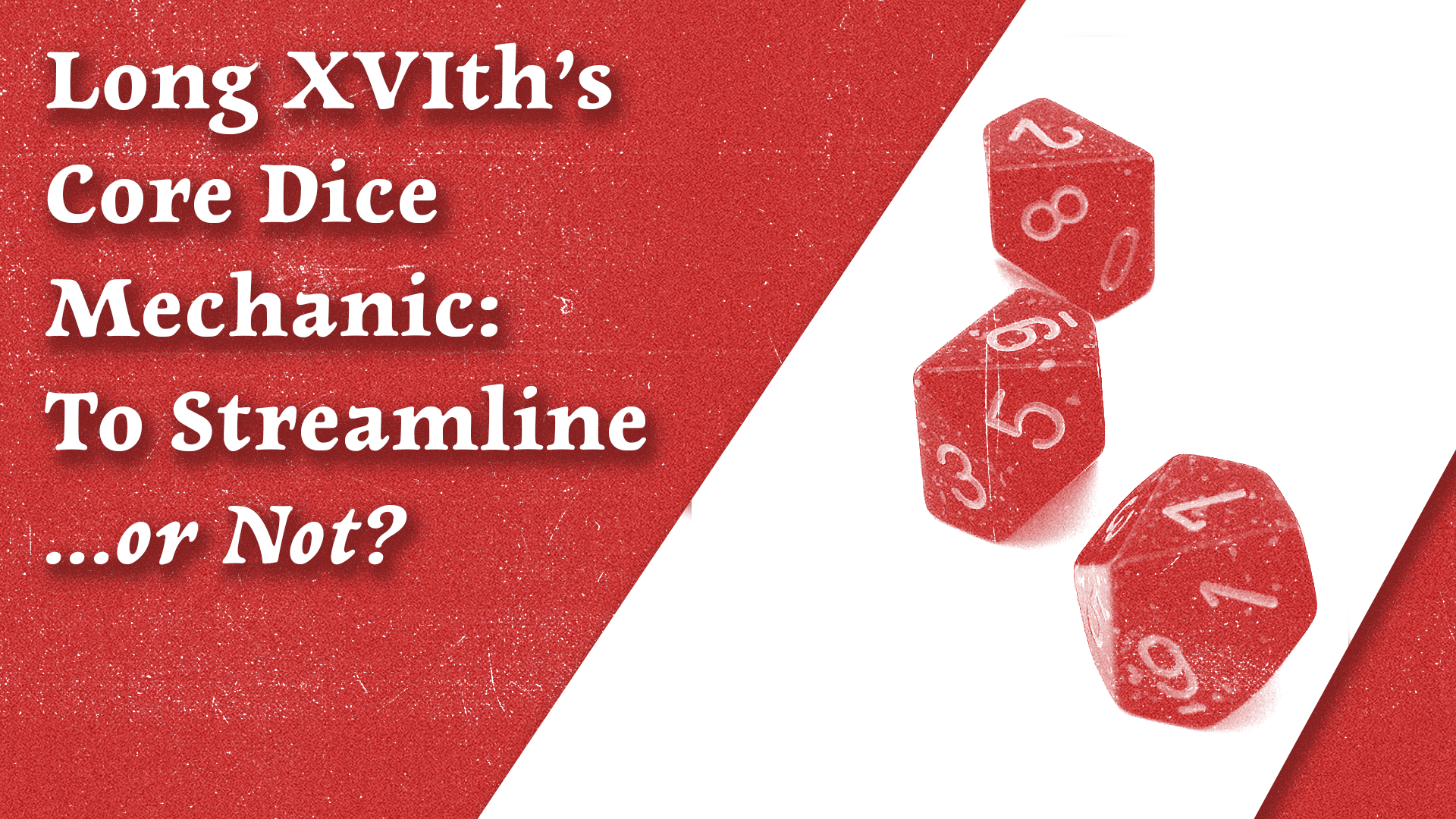I’m almost a half-dozen playtest sessions of Long XVIth in, and I’m happy to say the core dice mechanic and gameplay loop appears to be working (on the whole).
However, some of what I’m seeing at the table has me considering streamlining the number of PC stats and how they interact with that core gameplay loop. I’ll welcome your feedback on the following!
Basic Gameplay Loop
(This doesn’t address everything, but is the general idea.)
- Action Rolls are a roll-under d10 dice pool.
- Practical difficulty is largely discarded in favor of swashbuckling risk vs. reward:
safe or boring actions roll 1d10; exciting or risky 2d0; jaw-dropping or dangerous 3d10 - Both successes and failures count (a rules-lite homage to FFG’s narrative dice);
enemies environmental hazards deal damage usually on failures.
- Practical difficulty is largely discarded in favor of swashbuckling risk vs. reward:
- Damage, negative statuses, and buffs are tracked by a combined track of narrative Conditions. Think FATE Consequences or City of Mist Statuses. There are no traditional hit points.
- Conditions are flexible: they can grant bonus successes and failures and can be attached to scenes/the environment like they can be to PCs. Because they are so abstract, this means there’s a lot of trust and good faith that must exist between players and the GM.
- You can get a maximum number of bonus successes and failures equal to the dice rolled: 1d rolls can get only a single bonus success and failure, while 3d rolls can get up to three each. This is to keep gameplay moving – so that players don’t bog down the table by hunting for a dozen bonuses to invoke.
- Like FATE and City of Mist, the meta gameplay loop involves creating and stacking positive Conditions while minimizing the negative ones to maximize your effectiveness.
Current PC Stats
Player Characters have a core block of three stats, presently:
- Three Instincts (Grit, Wits, Panache) describe their overall abilities and instincts. Generated 1d6+1 for scores of 2-7.
- Three Attitudes (Belief, Honor, Station) function as “alignment with teeth” – similar to Pendragon’s paired traits. 1d10 rolls for a full 1-10.
- I’ve been tinkering with names for both sets. Still in flux.
- Those aforementioned 1-3d10 action rolls – plus some 1d reaction checks – are roll under the relevant Instinct or Attitude.
- Players can gain bonus successes (and failures) through the double edged set of four Attributes (Temperament, Social Class, Profession, & a campaign faction Entanglement). Scores of 0-3, and each Attribute as a list of options analogous to Race & Class from d20/OSR games.
This leaves us with a character sheet looking like this:

This all integrates into the core gameplay loop just fine, save for two issues:
- It takes time for Players to realize they can get bonuses from their Attributes (i.e. “Oh, that’s what those numbers mean.”)
- As a consequence of their Attribute scores, players rarely create helpful Conditions, and so their PC’s Conditions track becomes just a bucket of HP most of the time. This is not the intent.
The Alternative: Streamlined Character Stats
This is an approach that attempts to solve these issues by consolidating and streamlining character stats. It is not without its own issues, as I’ll explain:
- The three Instincts go away. Poof.
- The four Attributes take their place. Temperament, Social Class, Profession, or the factional Entanglement become the target number for rolls for anything a Character wants to do (using the generation and 2-7 scores from the Instincts).
- My hypothesis: this approach simplifies and reduces the numbers players have to be paying attention to.
- Without Attributes acting as a source for bonus successes, Players will have to work to create advantageous Conditions more often.
- Potential Issue – Actions that Don’t Easily Align with an Attribute? This setup leans hard into the Character’s place in society and handwaves away their physical and mental capabilities. If a Melancholic Upper Class Patrician Chaplain is tumbling down a mountainside, what does his player roll to save them?
- Solution A – Penalties and Bonuses: Player gets a bonus failure when acting at the margins or outside the focus of the Attribute (and the inverse is true: free bonus success when acting within their Attribute’s focus).
- This gives the Players a little more flexibility in edge cases: perhaps that Upper Class upbringing kept them in shape? Roll it with an automatic failure added to the results.
- However, this means that Characters with higher randomly generated Attribute scores (an OSR-inspired design choice) may fair better than other, more appropriately Attributed characters with lower scores. e.g. One PC who is a Doctor 7 will be more effective in battle, even with a penalty, than another PC who is a Soldier 4.
- Solution B – Narrow Attribute Focuses: This doubles down on the spotlight given Attributes, which may not be a bad thing given the game’s larger goal of introducing the world of sixteenth-century Europe. If your action is relevant enough to one of your Attributes, roll against that target number. If not, too bad: your target number is 2. Our hypothetical Patrician Chaplain falling down the mountainside might be in for a bad time. Attributes don’t grant bonus successes or failures. This has two side effects:
- Prevent the counter issue of higher-scoring inappropriate Attributes outperforming poorer quality, but more appropriate Attributes within their given ability and skill set (e.g. that combat issue).
- Force players into thinking creatively how to leverage their Attributes in the most beneficial way. Everything’s a nail when all you have in a hammer, but how will you use your hammer when a quill pen is most effective?
- Solution C – Leave the Three-Stat Block Structure In Place: Of course, I may find that having separate Instincts is worth the dearth of players creating positive Conditions!
Right now, I’m likely to move forward with Solution B. At least for this Sunday’s playtest with my ongoing campaign group. I’ve updated the character sheet to reflect those changes, which gets us this:

Any Feedback?
Would love to get outside thoughts onto how these changes sound. Any edge cases I’m not thinking about? Any questions? Does this streamlined approach to character stats sound like a valuable design choice?


[…] – Streamlined Stats: The streamlining of the character stats to focus on the Temperament / Social Class / Profession / Entanglement archetypes (jettisoning […]